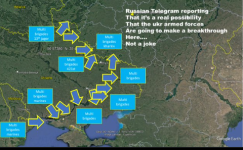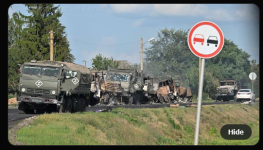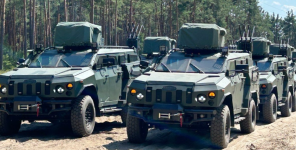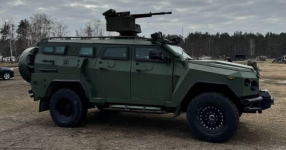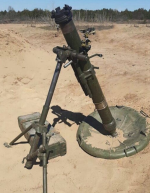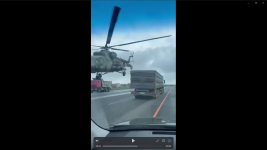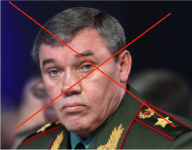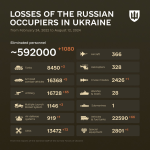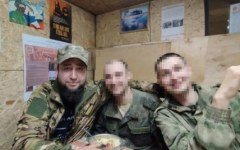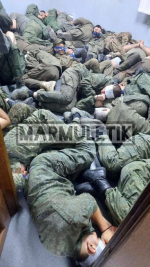ll74
Your Best Friend
- Joined
- Aug 22, 2013
- Posts
- 48,850
Copy pasta breaking forum rules.The Ukrainian offensive into the Kursk Oblast of the Russian Federation is ongoing and at this point, we can be sure it's not a ‘raid’. Ukraine is releasing next to no information on the ongoing situation, operational security is tighter than a nun's ass, and most of what is known is coming from Russian milblogger sources and feeds, along with a few images Ukraine releases to the media. A couple of examples: Russian authorities have acknowledged a "breakthrough" in another district of the Kursk region, with fighting now reaching the Belovsky district, according to the acting governor of the Kursk region, Alexey Smirnov, on Telegram. He also claimed that, as of now, there are no ongoing battles in the Belovsky and Oboyansky districts of the Kursk region. It is worth noting that yesterday, Russian so-called "war correspondents" complained about a new attempted breakthrough in the Kursk region, specifically in the Belovsky district, south of the city of Sudzha. This marks a new direction, as previous fighting had been concentrated in the Sudzha and Korenevo areas.
Yesterday, Russian propagandists claimed that Ukrainian forces had allegedly "taken control" of the area around the village of Belaya. They also reported the arrival of a new brigade and equipment. Again, Ukraine has not released any info about units involved in the attack. Most pf what's known comes from Russian sources, which may or may not be accurate. Ukrainian officials and military command have so far not officially commented on the operation in Kursk Oblast, media are forced to rely on limited and questionable information circulated by Russian Telegram channels and videos of Ukrainian forces that often surface anonymously.
So lets take a look at the situation: first, this operation appears to be being run in the ‘best traditions of Soviet military doctrine’. General Syrsky (chief of the Ukrainian GenStab, or ‘GenStab-U’) is adapting new technologies to his procedures but this operation is a ‘perfect example of Soviet military doctrine, with a few modern-day ingredients’ added into the mix. The result is a ‘well-prepared’ (near-perfect reconnaissance) and better-planned operation than usual. This also better fits the ZSU – not only because of the way the bulk of the ZSU's officers and troops are trained, but also because (unlike any Western/NATO armed force) the ZSU cannot count on any kind of serious air support from the Ukrainian Air Force (this doesn't mean the PSU and/or the ZSU’s Army Aviation aren’t involved, just that they don't have the #'s of aircraft and attack helicopters to do this on a western scale). What’s also better fitting the ZSU is that they are now fighting mobile warfare, instead of having to grind through 20-km deep Russian minefields…not to mention not having to dog in and hold trench lines while being exposed to constant shelling by the Russian artillery.
So, what seen is (6 August) the ZSU first infiltrating the border: subjecting forward Russian positions to a mass of FPV-strikes while its troops encircled forward enemy positions. Once this was done, the ZSU advanced north over the border, overrunning something like three poorly-trained Russian battalions (two were overrun, the third smashed while it attempted to counterattack). That was on 6-7 August. Simultaneously, the ZSU was running raids deep into the Russian rear, while confusing the GenStab in Moscow by turning east, infiltrating and securing Sudzha, and crossing the first Russian defence line constructed – and well-fortified - in this area at the most opportune point: where the line was only poorly protected, i.e. barely occupied by any troops (this was completed by the end of 7 Aug). To keep the Russians off balance, at the same time the ZSU ‘fanned out,’ carrying out additional raids and wreaking havoc in the Russian rear all the way up to Korenovo, and then in the direction of towns along the E38 highway like ivanovskoe, Lgov and Chermoshnoi.
This pre-empted the slowly-reacting Russian GenStab: which was caught with its pants down and with no clue as to what was going on. Because it had no idea what was going on, it also had no plan for this eventuality. The Russian Army simply can’t fight if it has no plan: it’s officers are trained to act according to heavily detailed procedures. If they have none, they’re doing nothing… or they're running away (like all the officers of the 488th Motor-Rifle Regiment did). What followed (since the evening of 7 August) was, de-facto, ‘as expected’ by the GenStab-U: the Russian GenStab continued using the E38 to move its reinforcements – in full sight of Ukrainian UAVs. This enabled the ZSU to obliterate several Russian intervention units with the help of long-range weaponry (M142 HIMARS and GLMRS). Combined with a power-outage in the Kurchatov area (unclear if this was caused by an intentional hit or because the Russians managed to shoot down an Ukrainian UAV which then crashed into one of local substations, as the Russians claim), this caused a mass panic amongst the local population.
Tens of thousands of Russian civuilians began fleeing east. Unsurprisingly, Russian reinforcements still trying to reach the combat zone are running into long car treks of ‘internally displaced persons’, which is slowing them down. Meanwhile, the ZSU is savaging Russian military columns along the libes of now widely circulated column of a Russian motor-rifle battalion taken out by a HIMARS or GLMRS strike while underway in Oktyabrskoe, 5km east of Rylsk, late on 7 August. Several other columns were hit in a similar fashion, which in turn is buying time for the ZSU to deploy yet additional forces (including its artillery) inside Russia, and then follow its early raids with serious advances.
Since yesterday the Russian command is insistent that the Russian Army has ‘stopped’ the Ukrainian advance, in reality, the ZSU is only ‘now’ (i.e. the last 36 or so hours) seriously advancing: expanding its ‘bridgehead into Russia’ from the Line connecting Snegost, Novoivanovka, Mala Loknya, Cherkasskoe Porechnoe, and Martynovka – in the northern and eastern directions. This is another detail taken from the Soviet doctrine: the advancing Ukrainian units are not wasting their time and troops with frontal assaults into urban areas. They’re first advancing between of these, scouting and raiding them, then encircling and infiltrating them, before ‘collapsing them from within’. Thus, except for what the UAVs and raiding elements are doing, no advance is really going ‘straight down the road’.
Moreover, and to rub salt into the wound, the ZSU has opened a major advance through the broken terrain south of Sudzha and secured the village of Plekhovo, south of Sudzha. With this, Russian units still holding out in the Makhnovka area, directly south of Sudzha, are threatened by envelopment on both flank. The only ‘unusual’ aspect of this operation would be the ‘economy of force’ the ZSU is exercising: the ZSU simply hasn’t got ‘dozens’ of brigades and battalions to spare. Still, it has something like a ‘Soviet-style Operation Maneuver Group’ (OMG) being held behind its advance units, capable of ‘exploiting’ the situation and waiting for an opportunity to drive deeper into Russia.
